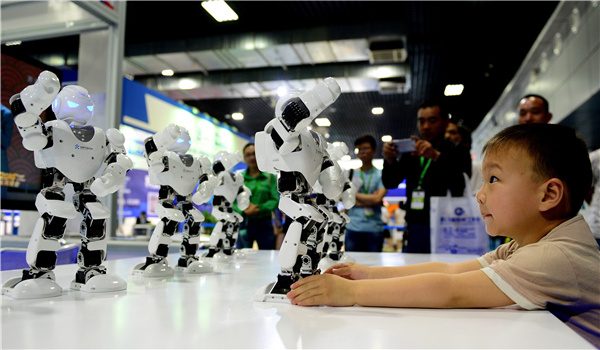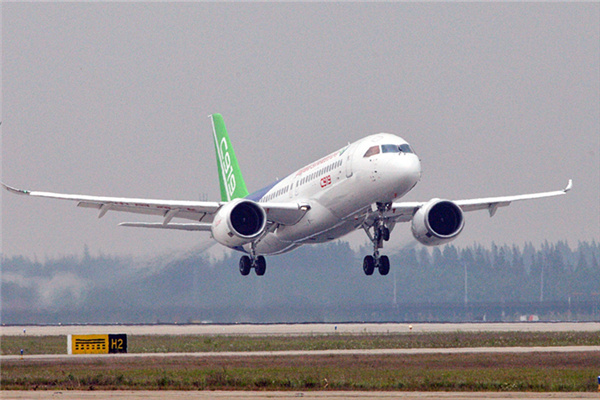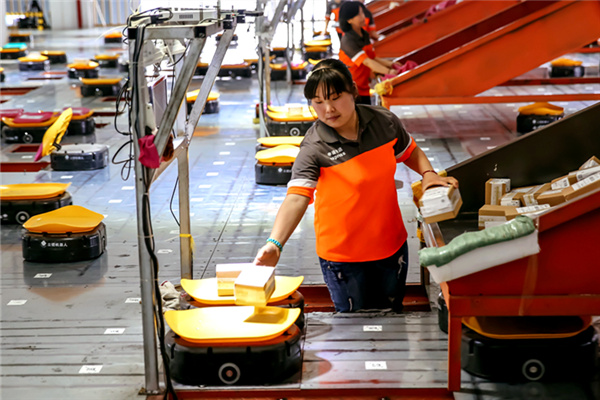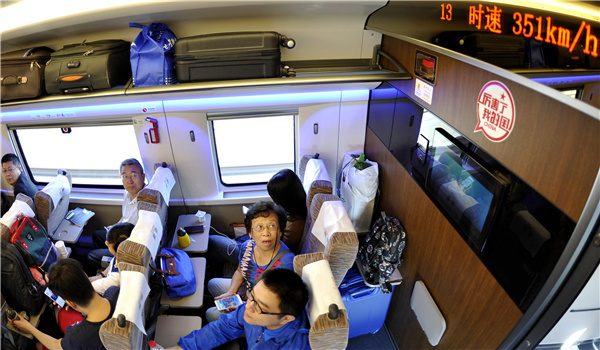
Late last month, a 2,000-kilometer-long quantum fiber link, the longest and most sophisticated in the world, was launched to connect Beijing and Shanghai and provide an unhackable communications route between the cities.
During the link’s launch in Beijing, Bai Chunli, president of the Chinese Academy of Sciences, used Micius, the world’s first quantum communication satellite which was launched by China last year, to make the first intercontinental quantum video call and spoke with Anton Zeilinger, his Austrian counterpart, in Vienna.
The breakthrough in quantum communication is one of a number of scientific achievements made by China in the past five years. Thanks to strong policy support and a growing pool of talent that is constantly pushing the envelope of technology, the world’s second-largest economy is rapidly being transformed from a follower to a global leader in innovation.
The shift is in line with the call by Xi Jinping, general secretary of the Communist Party of China Central Committee, on Wednesday for more efforts to make China into a country of innovators and reach the frontiers of science and technology.
Innovation is the primary force driving development, and it is the strategic underpinning for building a modernized economy, Xi said in a report delivered to the CPC’s 19th National Congress.
“We will strengthen basic research in applied sciences, launch major national science and technology projects, and prioritize innovation in key generic technologies, cutting-edge frontier technologies, modern engineering technologies, and disruptive technologies,” the president added.
Progress has already been made in the past five years, and China has emerged as a leader in the field of technology, with breakthroughs ranging from the maiden flight of the country’s first homegrown large passenger aircraft to the debut of the fastest train in the world, from the Beidou Navigation Satellite System, which is set to cover the world by 2020, to robotics and artificial intelligence technologies that are widely regarded as the next frontier of growth.
According to the 2017 report of the World Intellectual Property Organization, China is the only middle-income country in the list of the world’s top 25 most innovative economies, where it is ranked 22nd.
The achievement was lauded by Wan Gang, minister of Science and Technology, who said, “On the whole, we have met the goal of ‘occupying a place’ in the major fields of science and technology, which lays a sound foundation for China to be an innovation powerhouse.”
Meanwhile, a special issue of the scientific journal Nature noted that “Chinese science has been moving at breakneck speed for the past few decades, fueled by vast infusions of cash and a rapidly growing technical workforce.”

Outstripping competition
According to Nature, China now boasts more researchers than the United States, outspends the European Union in research and development and “is on track to best all other nations in its yearly production of scientific papers”.
Bai, from CAS, commented: “Important scientific work has mushroomed in China in recent years. It is the result of years of research and development. Policy guidance, financial support and continued efforts to deepen reform have all played parts in stimulating this vitality.”
More important, according to analysts, scientific research has been efficiently commercialized, with China pouring large sums into the latter stages of the R&D process, during which discoveries are turned into products.
High-speed rail has been one of the most impressive areas of progress. In recent years, China has built the world’s largest high-speed rail network and become a world leader in providing globally competitive high-speed products and services.
By 2020, China Railway Rolling Stock Corp, which manufacturers the country’s high-speed trains, is expected to supply new bullet trains with a maximum operating speed of 400 kilometers per hour to markets related to the Belt and Road Initiative. The new trains will also cut per passenger energy consumption by 10 percent, compared with trains that run at 350 km/h.
“Over the past few years, China has demonstrated its competitive edge in high-speed rail technology,” said Wang Mengshu, a railway expert and a member of the Chinese Academy of Engineering.
Navigating the future
After it was confirmed that Beidou, the homegrown navigation satellite system, covered the entire Asia-Pacific region in 2012, several more satellites were launched, enabling wider applications in logistics, aviation, precision farming and other industries that demand high-accuracy positioning.
Earlier this month, for the first time, Beidou was used to guide a Chinese-developed regional jetliner as it successfully completed a test flight at an airport in the eastern province of Shandong.
The flight demonstrated that Beidou’s performance is on a par with similar systems produced overseas and meets internationally advanced levels in transient and quick positioning index, according to the plane’s manufacturer, Commercial Aircraft Corporation of China.

Meanwhile, a tide of innovation is sweeping China, helping the country to evolve from an “innovation sponge”, absorbing and adapting existing technology and knowledge from around the world, into a global leader in innovation, spawning a wide range of homegrown cutting-edge products and services.
Nothing better demonstrates this than the bike-sharing phenomenon. Created by Chinese players, including Ofo and Mobike, GPS-enabled, dockless bikes are now improving the lives of people in big cities at home and abroad who are fed up with congested roads and long for zero-emissions forms of transportation.
In September, Ofo announced that it would launch its services in four European countries-the Czech Republic, Italy, Russia and the Netherlands-moving the company closer to meeting its ambitious goal of entering 200 cities in 20 countries by the end of the year.
“In stark contrast to the previous generation of Chinese companies that focused on domestic growth until the market became saturated, emerging startups are better at coming up with their own ideas and better aware of the opportunities abroad,” said Zhang Xu, an analyst at Analysys, a market researcher in Beijing.
The surge in mass entrepreneurship and innovation, buoyed by favorable government policies, is noticeable. By the end of last year, the country had nearly 26 million registered private and State-owned businesses, a rise of 18.8 percent from the previous year, according to the National Development and Reform Commission.
More important, 71 internet companies are “unicorns”, that is, private businesses valued at more than $1 billion each. Notably, four of them-Didi Chuxing, Xiaomi, Lu and Meituan-Dianping-have made the list of the world’s 10 most valuable unicorns.
According to the Ministry of Industry and Information Technology, China’s artificial intelligence sector is now equal to those in leading global powers in terms of voice, image and semantics recognition technologies.
Li Shu, a partner at Boston Consulting said: “China is a global pioneer in the field of internet development, as the growth in the number of netizens and the volume of internet consumption both top the corresponding rates in other nations. We have found that innovation permeates much quicker in China than the United States because Chinese netizens are more willing to accept new applications.”
Online shopping
For example, online shopping is now the norm for hundreds of millions of Chinese consumers. The advent of e-commerce, online payment and courier services means consumers can have goods delivered to their doorsteps within hours with just a few taps on their mobile gadgets.

In the past five years, China’s online retail market has surged from 1.3 trillion yuan ($196.5 billion) to 5.2 trillion yuan, raising living standards in both big cities and villages, according to a report released this month by Alibaba’s research unit.
Juggernauts such as Alibaba and JD.com have lured shoppers through the use of annual discount shopping galas that could eventually eclipse Black Friday in the US.
Moreover, smaller players are pushing ahead with the digital shopping frenzy by connecting a larger number of affluent Chinese with a wide array of foreign goods, while companies such as Red and Kaola, which is owned by NetEase, are heavily promoting cross-border e-commerce.
Market researcher eMarketer estimates that by 2020, half of China’s digital shoppers-about one-quarter of the country’s population of 1.4 billion-will be buying foreign products online and total sales will top $157 billion.
Likewise, the country’s mobile payment industry has made its mark in the outside world by moving away from its original function of simply facilitating transactions and embracing new activities such as wealth management, credit scoring and utility bill payments.
Girish Ramachandran, Asia-Pacific president of Tata Consultancy Services, India’s largest information technology company, said China’s rapid strides in digital technologies and innovation capability have indirectly inspired India to digitize its economy.
For example, Ant Financial Services, the owner of China’s largest mobile payment service, has brought its wireless payment solutions to its Indian counterpart Paytm.com, and the two signed an agreement in 2015 to create a local version of Alipay.
Zhang Wentao, a college student in Beijing, is typical of the younger generation, which has grown up in the midst of China’s tech revolution: “When I go out, I don’t bother to take a wallet. A smartphone is all I need to buy almost everything I need.”



